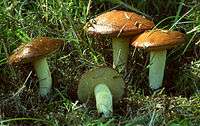Suillus granulatus
| Suillus granulatus | |
|---|---|
 | |
| Scientific classification | |
| Kingdom: | Fungi |
| Division: | Basidiomycota |
| Class: | Agaricomycetes |
| Order: | Boletales |
| Family: | Suillaceae |
| Genus: | Suillus |
| Species: | S. granulatus |
| Binomial name | |
| Suillus granulatus (L.) Roussel (1796) | |
| Synonyms[1] | |
| |
| Suillus granulatus | |
|---|---|
|
| |
| pores on hymenium | |
|
cap is flat or convex | |
|
hymenium is adnate or decurrent | |
| stipe is bare | |
| spore print is brown | |
| ecology is mycorrhizal | |
| edibility: edible | |
Suillus granulatus is a pored mushroom of the genus Suillus in the family Suillaceae. It is similar to the related S. luteus, but can be distinguished by its ringless stalk. Like S. luteus, it is an edible mushroom that often grows in a symbiosis (mycorrhiza) with pine. It has been commonly known as the weeping bolete,[2] or the granulated bolete.[3]
Taxonomy
Suillus granulatus was first described by Carl Linnaeus in 1753 as a species of Boletus.[4] It was given its current name by French naturalist Henri François Anne de Roussel when he transferred it to Suillus in 1796.[1] Suillus is an ancient term for fungi, and is derived from the word "swine". Granulatus means "fine grain".[5]
Description

The orange-brown, to brown-yellow cap is viscid (sticky) when wet, and shiny when dry, and is usually 3 to 9 cm in diameter. The stem is pale yellow, of uniform thickness, with tiny brownish granules at the apex. It is without a ring. The tubes and pores are small, pale yellow, and exude pale milky droplets when young. The flesh is also pale yellow.
Suillus granulatus is often confused with Suillus luteus, which is another common and widely distributed species occurring in the same habitat. S. luteus has conspicuous a partial veil and ring, and lacks the milky droplets on the pores.[6]
Distribution and habitat
Grows with Pinus (pine trees) on both calcareous and acid soils, and sometimes occurs in large numbers. Suillus granulatus is the most widespread pine-associating Suillus species in warm climates.[7] It is common in Britain, Europe, and North America. It is associated with Japanese red pine (Pinus densiflora) in South Korea.[6] A native to the Northern Hemisphere, the fungus has been introduced into Australia under Pinus radiata. It is also found in Africa, New Zealand, Hawaii, and southern Chile.[8]
Edibility
Suillus granulatus is edible and fair. Like all Suillus species, the tubes are best removed before cooking. It is sometimes included in commercially produced mushroom preserves. Has been known to cause mild stomach upsets. The fruit bodies—low in fat, high in fiber and carbohydrates, and a source of nutraceutical compounds—can be considered a functional food.[9]
Toxicity
Suillus granulatus sometimes causes contact dermatitis to those who handle it.
See also
References
- R.Phillips-Mushrooms 2006
- Marcel Bonn-Mushrooms and Toadstools of Britain and North West Europe.
- 1 2 "GSD Species Synonymy: Suillus granulatus (L.) Roussel". Species Fungorum. CAB International.
- ↑ Eppinger M. (2006). Field Guide to Mushrooms and Other Fungi of Britain and Europe. New Holland Publishers. p. 38. ISBN 978-1-84537-474-7.
- ↑ McKnight VB, McKnight KH (1987). A Field Guide to Mushrooms: North America. Peterson Field Guides. Boston, Massachusetts: Houghton Mifflin. p. 208. ISBN 978-0-395-91090-0.
- ↑ Linnaeus C (1753). "Tomus II". Species Plantarum (in Latin). Stockholm: Laurentii Salvii. p. 1177.
- ↑ David Arora (1986). Mushrooms Demystified. Ten Speed Press. ISBN 0-89815-169-4.
- 1 2 Min YJ, Park MS, Fong JJ, Seok SJ, Han S-K, Lim YW (2014). "Molecular Taxonomical Re-classification of the Genus Suillus Micheli ex S. F. Gray in South Korea". Mycobiology. 42 (3): 221–28. doi:10.5941/MYCO.2014.42.3.221. PMC 4206787
 . PMID 25346598.
. PMID 25346598. - ↑ Richardson DM. (2000). Ecology and Biogeography of Pinus. Cambridge University Press. p. 334. ISBN 978-0-521-78910-3.
- ↑ Simberloff D, Rejmanek M (2010). Encyclopedia of Biological Invasions. University of California Press. p. 470. ISBN 978-0-520-94843-3.
- ↑ Reis FS, Stojković D, Barros L, Glamočlija J, Cirić A, Soković M, Martins A, Vasconcelos MH, Morales P, Ferreira IC (2014). "Can Suillus granulatus (L.) Roussel be classified as a functional food?". Food & Function. 5: 2861–9. doi:10.1039/C4FO00619D. PMID 25231126.
External links
| Wikimedia Commons has media related to Suillus granulatus. |